In February we launched this year's David Miller Travel Bursary Award which provides travel grants of £250 to students in the second or final year of a higher education qualification (BSc, HND, Kew Diploma etc) or studying for an MSc or PhD who wish to undertake travel as part of their studies. Please let any students who you feel might be interested know about this award and encourage them to apply. We are particularly pleased to have received support from VHB Herbs which has enabled us to make two awards available this year.
Editor
A walk on the wild side

Or so I'm told. I don't do swaying walkways, with fellow visitors jumping up and down just behind me. But I was happy to yomp at ground level, guided by Mr Prince, who recognised the hand of the Creator in providing plant species that fulfil mankind's every purpose - building, furniture, boats, dyeing, musical instruments, fish traps, medicine … name your need, and the forest will provide.
Walking in filtered light and gazing upwards at the tops of trees 30m+ above you is like craning your neck, childlike, at impossibly tall grown-ups in flared trousers, carrying umbrellas; many forest species have buttressed trunks. More prominent species bore labels, but reading them sometimes entailed a scramble up a steep bank, with the risk of disturbing an ant route-march. One of our party did just that, and suffered a formic acid overload.
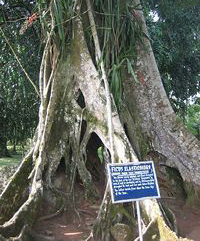
But the tree that impressed the most has no immediate use in Mr Prince's list of useful plants. This was the Strangler Fig (Ficus sp; possibly Ficus elasticoides (pictured right). Believe me, it deserves the capital letters to its common name. It begins life as an epiphyte, its seeds excreted by passing birds. Once a seedling has taken hold in the canopy, its host is doomed. Adventitious roots snake down, to establish a foothold in the forest floor. Its liana growth gradually surrounds the host trunk. Its canopy of leaves screens the sunlight. Here in temperate climes, we witness similar events when our native ivy overwhelms a hedgerow oak or ash; the supporter ends up as a prop for the rampant climber.
But the Strangler Fig goes one step further. It dispenses entirely with its host, so you may see a skein of interlaced stems surrounding the empty space where once the host tree lived and photosynthesised.
You may have wondered where Anish Kapoor got his inspiration for the ArcelorMittal Orbit sculpture on the 2012 Olympic site. A molten crane? French knitting gone seriously wrong? No. Anish Kapoor must have seen a Strangler Fig somewhere on his travels, and wished to pay tribute to its all-encompassing will to succeed.
Margaret Waddy
Plant of the Month
Abeliophyllum distichum , white forsythia, Oleaceae
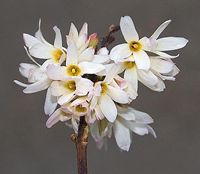
Abeliophyllum is a monotypic genus in the olive family (there is only a single species in the genus). It comes from Korea where there are fewer than 20 plants left in the wild. Thankfully it is relatively widely cultivated. Interestingly, in contrast to other countries in the region, Korea has only a handful of endemic genera. (Two others are Megaleranthis of the buttercup family and Pentactina in the rose family).
The name abeliophyllum means with leaves resembling an Abelia whilst distichum means 'in two ranks'. Characteristically, plants in the Oleaceae have only two stamen, and the flowers exhibit radial symmetry and are typically sweetly scented. Other plants in the family include jasmine and olives.
Consult the RHS Plant Finder to identify local nurseries selling this beautiful plant.
Alison Foster
Oxford Botanic Garden
Medicinal Plant of the Month
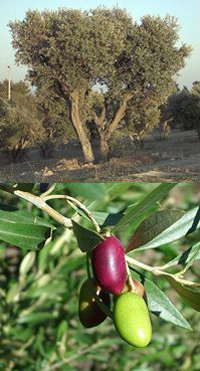
Traditionally thought of as a symbol of goodwill, the olive branch (or rather twigs of the olive branch) is used as a toothbrush in Saudi Arabia.
However the product of this tree (upper picture), namely the pressed oil from the fruit (technically a drupe, with an oily mesocarp surrounding the seed (lower picture), is one of the most common oils used in cooking and food preparation in this country today. But we are less familiar with the tree itself as it is only grown in sheltered spots in this country. It is widely cultivated in the Mediterranean (from whence it originates), Africa, Australia and South America.
We often hear how good the oil is for us (relative to other cooking oils) but can it be claimed to be medicinal? It is not the oil that leads to the presence of the olive tree as the March plant of the month.
In Mediterranean countries the olive leaf has traditionally been used as a remedy for a wide variety of ailments. It is used mainly as an antihypertensive (to lower blood pressure) and diuretic, but also for its hypoglycaemic, antipyretic and antispasmodic activities. The leaves contain a range of compounds - secoiridoids (oleuropein, ligustroside and oleacein), triterpenoids, sterols, flavonoids (chrysoeriol and apigenin and luteolin glycosides) and various phenolic acids. With such a complex mixture of components present it is hard to establish which of the substances is responsible for any of the bioactivity.
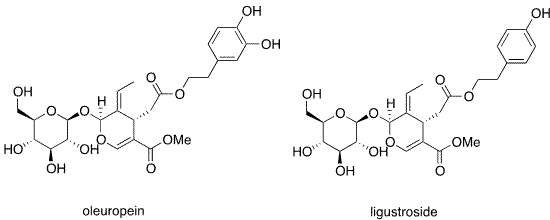
Oleuropein has been the subject of many studies into its biological activity and has been shown to lower blood pressure by increasing coronary flow, to inhibit the angiotensin converting enzyme (with potential for lowering blood pressure) and to show neuroprotective effects.
The oil is however, used as an excipient in some drug preparations - as a solvent, and in some parenteral preparations (sterile formulations intended for administration as injection, infusion or implantation).
Maybe, however we should take some advice from the Greeks (no, not financial advice). They recommend taking a spoonful of green oil (made from pyrene oil from the stones) before an evening's drinking to prevent drunkenness!
Alison Foster
Oxford Botanic Garden
Horticulture Industry News
For the very latest horticultural news follow us on Facebook and or
Twitter.
Tribal knowledge proves superior
Scientists studying the indigenous knowledge of millet varieties within a tribal community in the Kolli Hills of Tamil Nadu state came away richer for 19 new classifications, some with medicinal properties and drought resistance. The indigenous method of classification led the scientists to conclude that 'biodiversity projects should consider the perspective of both traditional and scientific knowledge when assessing, managing and conserving biodiversity.' Appearance, agricultural use and food quality were found important for tribal classification. Examples are 'thirikulasama', a drought-tolerant millet, and 'kottapattisama', which has a desirable and distinctive taste and is made into a drink. More
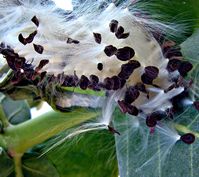
The Apple of Sodom (Calotropis procera) plant is often regarded as a nuisance, but thanks to researchers in Saudi Arabia it could now be the source of a novel insulating material. Lead researcher Dr Mohamed Ali explained: 'This plant tends to grow in very dry areas. It grows naturally all around as a weed and animals can't eat it, so it doesn't have that many uses.' Unlike other natural insulating materials, such as wood fibre (also used for paper, tissue, cardboard etc) or mineral wool (also used in plastics and the automotive industry), this means that there is no competition with other sectors or livelihoods.
'What interested me about it were the seedpods. Inside there are lots of white fibres attached to the seeds - I collected these fibres and did some experimenting.' To make the insulator, Dr Ali and his colleagues combined the plant's fibres with a binding resin called phenolic formaldehyde, and compressed it to a thickness of around 2 cm. The resulting material was a stiff board with good insulating properties. They then discovered that the finished product was just as good if natural corn starch was used in place of phenolic formaldehyde, resulting in a natural, eco-friendly material that would be cheap to produce and completely safe to use in houses.
Back to life after 30,000 years
Scientists in Russia have grown plants from fruit stored away in permafrost by squirrels over 30,000 years ago. The fruit was found in the banks of the Kolyma River in Siberia, a top site for people looking for mammoth bones. The Institute of Cell Biophysics team raised plants of Silene stenophylla from the fruit. The squirrels appear to have stashed their store in the coldest part of their burrow, which subsequently froze permanently, presumably due to a cooling of the local climate. More
Genes travel further than you think
The evolution of plants and animals generally has been thought to occur through the passing of genes from parent to offspring and genetic modifications that happen along the way. Evolutionary biologists from Brown University and the University of Sheffield have now documented another avenue, through the passing of genes from plant to plant between species with only a distant ancestral kinship.
How this happened is unclear. But the researchers show that not only did a grouping of grasses pass genes multiple times over millions of years, but that some of the genes that were transferred became integral cogs to the plants' photosynthetic machinery, a critical distinguishing feature in C4 plants, which dominate in hot, tropical climes and now make up 20 percent of the Earth's vegetational covering. More
Productive farms can be 'greener than organic'
Farms that aim for high food production using environmentally-friendly practices could be better for the environment than both organic and conventional farms. In a study, led by Oxford University scientists, they compared the environmental impact of different farming systems and found that 'integrated' farms that maximised crop yields whilst using environmentally-friendly techniques - such as crop rotation, organic fertilisers, over winter cover crops, and minimal use of pesticides - would use less energy and generate lower greenhouse gas emissions per unit of production than both organic and conventional farms.
Predicting the medicinal uses of plants
Studying the traditional uses of medicinal plants has led to discoveries that have helped combat diseases and improve healthcare. However, the development of quantitative measures to assist in our quest for new medicinal plants has not greatly advanced in recent years.
PhD student Haris Saslis-Lagoudakis, co-supervised by Julie Hawkins (University of Reading) and Vincent Savolainen (Kew/Imperial College London), has compared medicinal uses within various floristic groups and looked at the phylogenetic patterns in a few case studies, including the legume Pterocarpus. His studies show that species of Pterocarpus used to treat certain conditions, such as malaria, are significantly clumped phylogenetically, highlighting the predictive power of phylogenetic trees in studying the medicinal uses of plants.
The underground world of plants revealed
Plant and computer scientists can now study the underground world of plants with more accuracy and clarity. The revolutionary technique will improve our chances of breeding better crop varieties and increasing yields. Developed at The University of Nottingham, the new approach is based on the same X-ray technology used in hospital CT scans and incorporates new image analysis software which, for the first time, can automatically distinguish plant roots from the other materials found in soil. The results of this research, which has already been demonstrated on the roots of maize, wheat and tomato. More
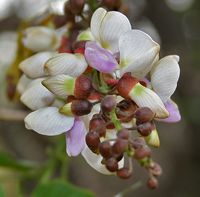
Millettia pinnata (syn. Pongamia pinnata) known as pongam tree, karum tree and poonga-oil tree, is a fast-growing, drought hardy evergreen that boasts delicious-looking lavender flowers that develop into a lush display of pods bursting with oil-soaked seeds. Native to India it can thrive in hot, dry climates elsewhere, and the biofuel company TerViva is planning to grow about a million acres of pongam trees for biofuel in the U.S., Texas and Canada over the next ten years.
Pongam seed oil has been used as a substitute for kerosene, and TerViva has developed an 'elite' strain that produces oil that shares the basic properties of other biofuel feedstocks. As a biofuel crop, pongam trees fit into the preferred mould of a non-food crop that requires little in the way of irrigation and pest control, so it can be grown on marginal lands. They also have a bonus advantage. Pongam trees are leguminous, which means they fix atmospheric nitrogen and do not require fertilizers. More
Ultraviolet protection molecule in plants yields its secrets
Ultraviolet (UV) radiation from the sun can damage proteins and DNA inside cells, leading to poor growth and even death (as well as carcinogenesis in humans). But plants have evolved some powerful adaptive defences, including a complex array of protective responses orchestrated by a UV-sensing protein molecule known as UVR8. Now, scientists from the Scripps Research Institute and the University of Glasgow have put together a detailed picture of UVR8's structure and inner workings.
Researchers first found evidence of UVR8's protective function in 2002, when they knocked out its gene in the wild mustard plant Arabidopsis, the standard experimental model for plant biologists. The mutant plants grew poorly when exposed to UV 'B' wavelength radiation - the range most responsible for tanning and burning of human skin. When UVR8 is present in Arabidopsis, it can sense UV-B light and switch on a broad protective response involving more than 100 Arabidopsis genes. 'These are genes for DNA-repair enzymes and other protective proteins,' said Getzoff. 'It's the plant equivalent of putting on sunscreen.' More
Events Calendar
Hortec, Kenya
POSTPONED, ECO
Nairobi, Kenya
Flora of the Avon Gorge
15 Mar, Bristol Botanic Garden
Bristol, UK
The Landscape Show
15 - 17 Mar
London, UK
International Congress on Hazelnut
19 - 22 Mar, Instituto de Investigaciones Agropecuarias
Temuco, Chile
Flowers & Hortec Poland
20 - 22 Mar, BTO Exhibitions
Warsaw, Poland
International Flower Trade Expo
21 - 23 Mar, HPP Exhibitions
Nairobi, Kenya
Meadows at the Olympic park: elysium in the east end?
22 Mar, Oxford Botanic Garden
Oxford, UK
Medicinal and Aromatic Plants
22 - 24 Mar, International Society for Horticultural Science
Djerba, Tunisia
Biotechnology of Fruit Species
25 - 29 Mar, International Society for Horticultural Science
Nelson, New Zealand
Hunting for sustainability: ecology, economics and society
26 - 28 Mar, Instituto de Investigación en Recursos Cinegéticos
Ciudad Real, Spain
Crop World North America
27 - 28 Mar,
Charlotte, USA
IPM on the World Stage-Solutions for Global Pest Challenges
27 - 29 Mar,
Memphis, USA
New Ag International Conference & Exhibition
28 - 30 Mar
Bangkok, Thailand
Advances in Plant Virology
28 - 30 Mar, Association of Applied Biologists
Dublin, Ireland
Flower Bulbs and Herbaceous Perennials
28 Mar - 1 Apr, International Society for Horticultural Science
Antalya, Turkey
Mechanical Harvesting & Handling Systems of Fruits and Nuts
2 - 4 Apr, International Society for Horticultural Science
Lake Alfred, USA
Valuing Ecosystems: policy, economic and management interactions
3 - 4 Apr, James Hutton Institute
Edinburgh, UK
Symposium on Artichoke, Cardoon and their wild relatives
10 - 13 Apr, International Society for Horticultural Science
Viterbo, Italy
Effective application: exploring synergy between Agricultural Economics and Applied Biology
16 - 18 Apr, Association of Applied Biologists
Warwick, UK
Registration of Agrochemicals
17 - 18 Apr,
Brussels, Belgium
Valuing Trees & Woodlands - a new understanding of their true worth
23 Apr, Institute of Chartered Foresters
Stoneleigh, UK
Symposium on Guava and Other Myrtaceae
23 - 25 April, International Society for Horticultural Science
Petrolina, Brazil
Protea Research Symposium
23 - 26 Apr, International Protea Association and International Society for Horticultural Science
Santiago, Chile
Insect Decline; The causes and the Role of Agriculture in Mitigation
25 Apr, SCI and Association of Applied Biologists
Harpenden, UK
History Comes to Life: Seventeenth-Century Natural History, Medicine and the 'New Science'
27 Apr, Society of Biology
London, UK
Biotechnology and other Omics in Vegetable Science
29 Apr - 2 May, International Society for Horticultural Science
Antalya, Turkey
Society of Biology AGM
3 May, Society of Biology
London, UK
Desert Green
7 - 9 May, Unido, UNDP, FAO
Qatar
Plasticulture for a Green Planet
15 - 17 May, International Society for Horticultural Science
Tel Aviv, Israel
Harnessing Emerging Technologies for Environmental Science
16 May, Environmental Virtual Observatory
London, UK
International Blackcurrant Conference
16 - 18 May, James Hutton Institute
Dundee, UK
Edible Alliaceae
16 - 19 May, International Society for Horticultural Science
Fukuoka, Japan
Mineral Nutrition of Fruit Crops
19 - 25 May, International Society for Horticultural Science
Chanthaburi, Thailand
Plum and Prune Genetics, Breeding and Technology
20 - 25 May, International Society for Horticultural Science
Davis, USA
Soilless Culture
22 - 25 May, International Society for Horticultural Science
Shanghai, China
If you would like to advertise a forthcoming event please contact. charne.green@soci.org
Horticulture Group Contact Details
For submitting ideas or to volunteer to be part of a committee or a group, please contact:
Chairman - Peter Grimbly
Meetings Secretary - Alison Foster
Minutes Secretary - Margaret Waddy
Newsletter co-ordinator - Sue Grimbly scihortigroup@btinternet.com
Group Contact - Charne Green charne.green@soci.org T: +44 (0)20 7598 1594
